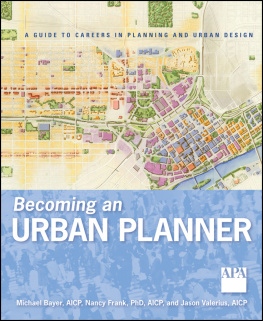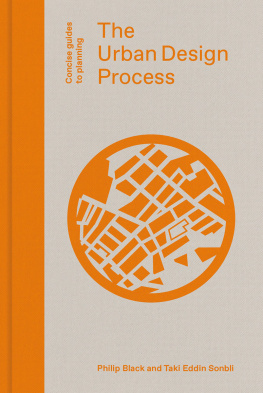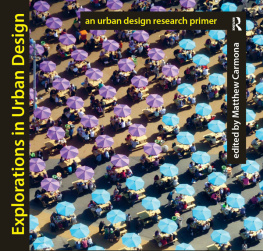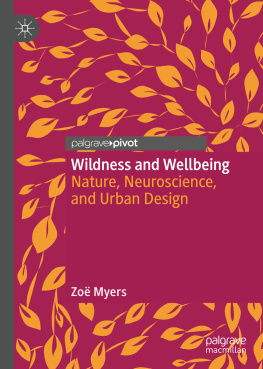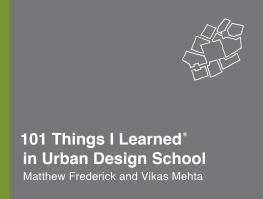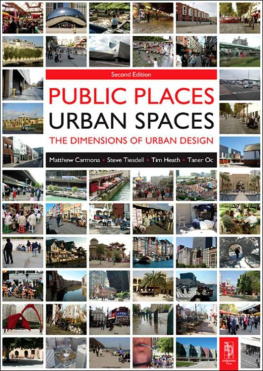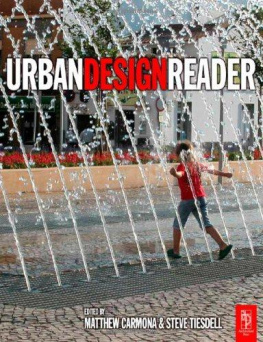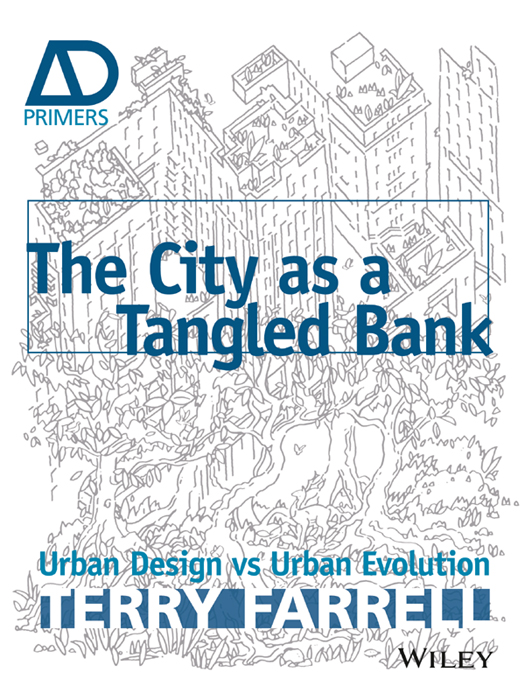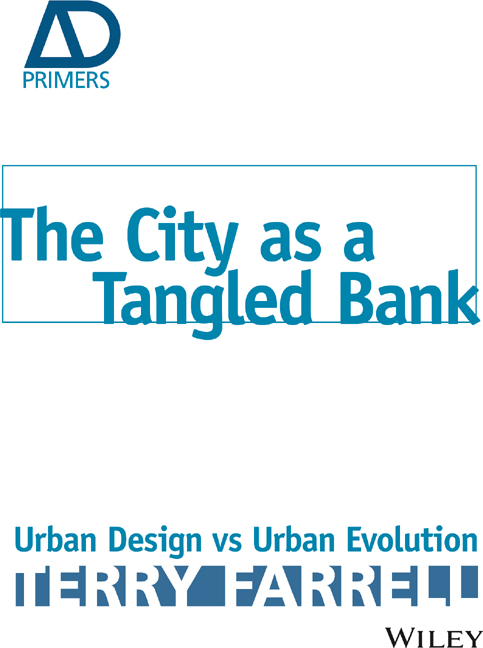The City as a Tangled Bank
This edition first published 2014
Copyright 2014 John Wiley & Sons Ltd.
Registered office
John Wiley & Sons Ltd, The Atrium, Southern Gate, Chichester, West Sussex, PO19 8SQ, United Kingdom
For details of our global editorial offices, for customer services and for information about how to apply for permission to reuse the copyright material in this book please see our website at www.wiley.com .
All rights reserved. No part of this publication may be reproduced, stored in a retrieval system, or transmitted, in any form or by any means, electronic, mechanical, photocopying, recording or otherwise, except as permitted by the UK Copyright, Designs and Patents Act 1988, without the prior permission of the publisher.
Wiley publishes in a variety of print and electronic formats and by print-on-demand. Some material included with standard print versions of this book may not be included in e-books or in print-on-demand. If this book refers to media such as a CD or DVD that is not included in the version you purchased, you may download this material at http://booksupport.wiley.com . For more information about Wiley products, visit www.wiley.com .
Designations used by companies to distinguish their products are often claimed as trademarks. All brand names and product names used in this book are trade names, service marks, trademarks or registered trademarks of their respective owners. The publisher is not associated with any product or vendor mentioned in this book.
Limit of Liability/Disclaimer of Warranty: While the publisher and author have used their best efforts in preparing this book, they make no representations or warranties with respect to the accuracy or completeness of the contents of this book and specifically disclaim any implied warranties of merchantability or fitness for a particular purpose. It is sold on the understanding that the publisher is not engaged in rendering professional services and neither the publisher nor the author shall be liable for damages arising herefrom. If professional advice or other expert assistance is required, the services of a competent professional should be sought.
ISBN 978-1-118-48734-1 (paperback)
ISBN 978-1-118-48729-7 (ebk)
ISBN 978-1-118-48730-3 (ebk)
ISBN 978-1-118-48731-0 (ebk)
ISBN 978-1-118-78319-1 (ebk)
Executive Commissioning Editor: Helen Castle
Project Editor: Miriam Murphy
Assistant Editor: Calver Lezama
Acknowledgements
This book began entirely at the suggestion of Helen Castle, Executive Commissioning Editor and Editor of Architectural Design (AD) at John Wiley and Sons. Once I had absorbed the potential of the idea (but, optimistically, as ever, underestimated the work involved!) I became engrossed in it and have worked on it for the best part of two years. Helen has stayed with its development all along; she has helped, steered and critiqued its direction and I am most grateful to her and all the staff at Wiley.
In our own office, Jenny Hughes, Duncan Whatmore, Max Farrell, Cerise Day and Raymond Lee all helped variously on texts, transcription of tapes, illustrations and captions. As ever I relied heavily on Emma Davies who helped enormously on picture research and text development, and liaised and coordinated all the parties.
Outside the office Emma Keyte took my rough texts and helped shape them at the early stages. Ed Wainwright was significantly helpful to me in composing thoughts and direction, and in particular in directing me to books and papers on the subject of emergence. And finally, in the chronological sense particularly, Abigail Grater edited the texts over these last few months on a truly heroic scale. Thank you Abi, youve done a wonderful job!
Of course, over my working lifetime so many have contributed to the practice projects and to the debate, and the formation of my urban planning thinking has been done in tandem with a group of really dedicated and creative people here at Farrells.
Terry Farrell, London, April 2013
Preface
As I sit down to write this book, I reflect on the fact that writing is not my primary activity; it is not something that I do every day. I am not a professional writer; I am a practitioner. The world of academia, of writing, researching and teaching, is something I only touch on and connect with now and then.
I spend my days in meetings, on site and drawing. I meet with my own staff in design and planning reviews, sketching, doodling and talking, with sheets of paper on the tables some tracing, some blank and plans, photos and Google maps on the walls, and bits of models everywhere. I walk around sites, town centres, cities, with a purpose, with a project, with a challenge of a physical kind. Increasingly I am in big workshops where, for some or all of the time, every player is present: town planners; local politicians; engineers of all kinds traffic, civil, structural; landscapers; and, increasingly, other architects, because collaboration has become much more acceptable. It is something I have always done, but it is increasingly the norm. There is always of course my home team in these workshops, various external project managers working for all sides, and ever more often the clients are there as professionals, as hands-on people replicating the other disciplines of town planning, engineering and construction. Sometimes and increasingly there are even professional architects within the client body. In this way there is a community, layering their work and, in so doing, replicating city making at large not by the hand of a single designer, but by a collective. This is still design, though through a more complex evolutionary process. And the resultant city is all the better for it. To paraphrase Charles Darwin, it can display qualities of grandeur, wonder and beauty, because the citys own life force always predominates.
In all of this I like to think I am not only action-orientated; I am not only doing the planning, designing and building of things. At the same time I am also evolving thoughts and ideas, coming to wider conclusions of a general theoretical nature, and of course, just as with all people of action, I am coming to these conclusions in a different way from the specialist, single-purpose building designer or the more removed academics, writers and theoreticians. When I sit down to write or research a book or an article, I discover more and more about the parallel universe I am in. I begin to realise that, while I think I have discovered afresh what I have learnt, what I have observed, and the general conclusions I have reached, in fact all I have done is discover them for myself within our wider culture. I realise there is a parallel world of theoreticians, writers and researchers who are all professionally involved in these specific areas, and invariably they have all worked it out before me, thoroughly, eruditely and well.
So to what extent is my writing of value in the face of such serious professional writing by others? Well, I believe the work of a practitioner has its own contribution to make to research, theory and writing. I have become passionate about cross connections because I am doing and observing. I see myself as something of a detective, like Sherlock Holmes. When working at the urban terrain, I take the view that everything is where it is for a reason but not necessarily for the particular purpose it has assumed. Another analogy I use is that the architect-planner should be like a city psychoanalyst, with the city on the couch. As Sigmund Freud, the father of psychoanalysis, wrote: There is, in fact, no better analogy for repression by which something in the mind is at once made inaccessible and preserved, than burial of the sort to which Pompeii fell victim and from which it could emerge once more through the work of spades. To be more removed in any way is to be self-limiting.


